天天学英语_一般现在时结构(疑问句)
一般现在时的结构和用法
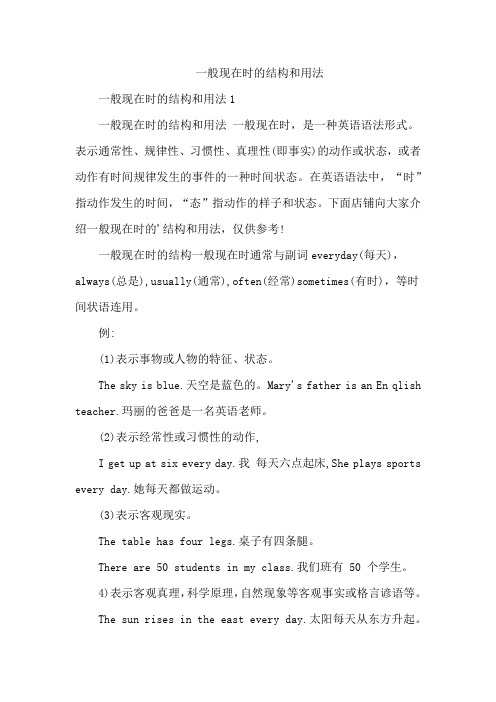
一般现在时的结构和用法一般现在时的结构和用法1一般现在时的结构和用法一般现在时,是一种英语语法形式。
表示通常性、规律性、习惯性、真理性(即事实)的动作或状态,或者动作有时间规律发生的事件的一种时间状态。
在英语语法中,“时”指动作发生的时间,“态”指动作的样子和状态。
下面店铺向大家介绍一般现在时的'结构和用法,仅供参考!一般现在时的结构一般现在时通常与副词everyday(每天),always(总是),usually(通常),often(经常)sometimes(有时),等时间状语连用。
例:(1)表示事物或人物的特征、状态。
The sky is blue.天空是蓝色的。
Mary's father is an En qlish teacher.玛丽的爸爸是一名英语老师。
(2)表示经常性或习惯性的动作,I get up at six every day.我每天六点起床,She plays sports every day.她每天都做运动。
(3)表示客观现实。
The table has four legs.桌子有四条腿。
There are 50 students in my class.我们班有 50 个学生。
4)表示客观真理,科学原理,自然现象等客观事实或格言谚语等。
The sun rises in the east every day.太阳每天从东方升起。
The earth goes around the sun.地球绕着太阳转。
(5) 表示平日的喜好。
I like bananas. We don't like vegetables.He likes ice cream.She doesn't like strawberries.一般现在时的用法经常性或习惯性的动作,常与表示频腮度的时间状语连用。
(1)时间状语:every.. sometimes, at.. on Sun dayi leave home for school at 7 every morning.(2)客观真理,客观存在,科学事实。
天天学英语_一般现在时结构(疑问句)

一般现在时的疑问句一、一般现在时变否定句的规则.一)、主语+be动词1、疑问句结构: be + 主语+ 其它部分?2、变换方法:一提二变三问号一提:即把句中的be动词调到句首;二变:改换主语称谓,即将句中的主语I\my \mines\we\our\ours等第一人称分别改为相应的第二人称you\your\ yours等;三问号:句末的句号改为问号.3、回答肯定回答用“Yes,主语+be.”,否定回答用“No,主语+be +not.但要注意人称的变化、在回答时必须将this\that与these\those分别变为it 和they。
【例】1、陈述句The girl is his sister.主语be动词疑问句Is the girl his sister ?be动词主语问号回答:肯定回答Yes, she is.否定回答No, she isn’t.2、陈述句He is a teacher.主语be动词疑问句Is he a teacher ?be动词主语问号回答:肯定回答Yes, he is.否定回答No, he isn’t.3、陈述句I am a teacher .主语be动词疑问句Are you a teacher ?be动词主语问号回答:肯定回答Yes, I am.否定回答No, I am not.4、陈述句 These are your English books.主语be动词疑问句Are these your English books?be动词主语问号回答:肯定回答Yes, they are.否定回答No, they aren’t.5、陈述句This is your English books .主语be动词疑问句Is this your English books?be动词主语问号回答:肯定回答Yes, It is.否定回答No, It isn’t二)、主语+情态动词1、疑问句结构:情态动词+ 主语+ 动词原形+ 其它部分?2、变换方法:一提二变三问号一提:即把句中的情态动词调到句首;二变:改换主语称谓,即将句中的主语I\my \mines\we\our\ours等第一人称分别改为相应的第二人称you\your\ yours等;三问号:句末的句号改为问号.3、回答肯定回答用“Yes,主语+情态动词.”,否定回答用“No,主语+情态动词+not但要注意人称的变化【例】1、陈述句I can speak English.主语be动词疑问句Can you speak English ?be动词主语问号回答:肯定回答Yes, I can.否定回答No, I can’t.三)、主语+实义动词1、疑问句结构当主语是第一人称;第二人称及第三人称复数及复数名词时:结构:Do+主语+实义动词+其他当主语是第三人称单数及单数名词时结构:Does+主语+实义动词原形+其他【例】1、陈述句He plays Ping-pang every day.主语义动词的第三人称单数形式疑问句Does he play Ping-pang every day.Does 主语动词原型回答:肯定回答Yes, he does.否定回答No, he doesn’t.四)、注意1、含有have和has的句子变成疑问句,把have和has看着实义动词,用do和does提问,但has要变成have【例】1、陈述句I have big eyes..疑问句Do you have big eyes?回答:肯定回答Yes,I do.否定回答NO,I don't.2、陈述句She has a small mouth.疑问句Does she have a small mouth?回答:肯定回答Yes,she does.否定回答No, she doesn't.2、见到some 变否定句时,要换成any.3、见到and 变否定句时,要换成or.4、见到too和also变否定句时,要换成either.5、见到already变否定句时,要换成yet。
小学英语语法 一般现在时

小学英语语法一般现在时一般现在时基本用法介绍【No。
1】一般现在时的功能1。
表示事物或人物的特征、状态。
如:The sky is blue。
天空是蓝色的。
2。
表示经常性或习惯性的动作。
如:I get up at six every day。
我天天六点起床。
3。
表示客观现实。
如:The earth goes around the sun。
地球绕着太阳转。
一般现在时的构成1。
be动词:主语be 其它。
如:I am a boy。
我是一个男孩。
2。
行为动词:主语行为动词。
如:we study English。
我们学习英语。
当主语为第三人称单数时,要在动词后加“-s”或“-es”。
如:Mary likes Chinese。
玛丽喜欢汉语。
【No。
2】一般现在时的变化1。
be动词的变化。
否定句:主语be not 其它。
如:He is not a worker。
他不是工人。
一般疑问句:Be 主语其它。
如:-Are you a student?-Yes。
I am。
/ No,I‘m not。
非凡疑问句:疑问词一般疑问句。
如:where is my bike?2。
行为动词的变化。
否定句:主语don’t 动词原形。
如:I don’t like bread。
当主语为第三人称单数时,要用doesn‘t构成否定句。
如:He doesn’t often play。
一般疑问句:Do 主语动词原形其它。
如:- Do you often play football?- Yes,I do。
/ No,I don‘t。
当主语为第三人称单数时,要用does构成一般疑问句。
如:- Does she go to work by bike?- Yes,she does。
/ No,she doesn’t。
动词s的变化规则1.一般情况下,直接加-s,如:cook-cooks,milk-milks2.以s。
x。
sh。
ch。
o结尾,加-es,如:guess-guesses,wash-washes,watch-watches,go-goes3.以“辅音字母y”结尾,变y为i,再加-es,如:study-studies。
四种时态总结

四种时态总结一般现在时总结1be动词的一般现在时be动词也称为“是动词”,表示“是”,一般现在时有is, am, are三个,与不同的主语连用,如下表:人称主语与be动词汉译文第一人称单数复数I amwe are我是我们是第二人称单数复数you areyou are你是你们是第三人称单数(男性)单数(女性)其他复数he isshe isit isthey are他是她是它是他们是1) be动词的肯定句、否定句、疑问句、肯定回答与否定回答结构如下:肯定句:主语+be动词+表语(名词、形容词、数词、介词短语等)否定句:主语+be动词+not+表语疑问句:be动词+主语+表语肯定回答:Yes,主语+be动词+表语否定回答:No, 主语+be动词+not+表语例:I am a student. 我是一名学生。
(肯定句)I am not a student.我不是一名学生。
(否定句)Am I a student?我是一名学生吗?(疑问句)Yes, you are.是的,你是。
(肯定回答)No, you are not.不,你不是。
(否定回答)We are young.我们年轻。
(肯定句)We are not young.我们不年轻。
(否定句)Are we young?我们年轻吗?(疑问句)Yes, we are.是的,我们年轻。
(肯定回答)No, we are not.不,我们不年轻。
(否定回答)It is rather expensive.这很贵。
Yes, it is.是的,很贵。
No, it isn't. 不,不很贵。
She is eleven.她11岁。
(肯定句)She is not eleven.她不是11岁。
(否定句)Is she eleven?她11岁吗?(疑问句)Yes, she is.是的,她11岁。
(肯定回答)No, she is not.不,她不是11岁。
(否定回答)You are right.你是对的。
一般现在时
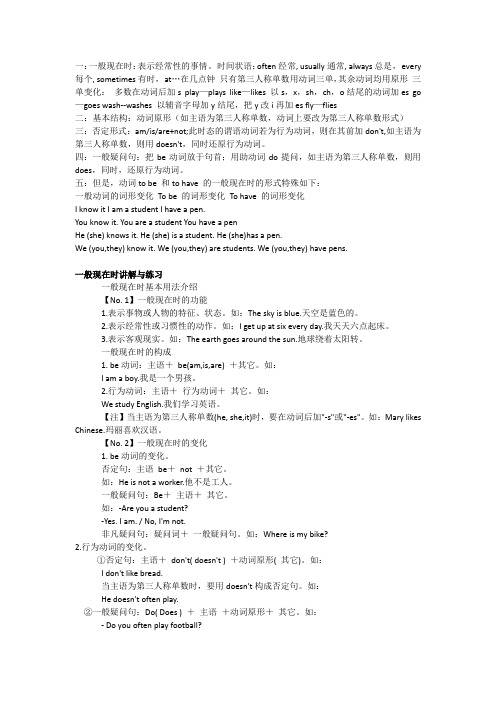
一:一般现在时:表示经常性的事情。
时间状语:often经常, usually通常, always总是,every 每个, sometimes有时,at…在几点钟只有第三人称单数用动词三单,其余动词均用原形三单变化:多数在动词后加s play—plays like—likes 以s,x,sh,ch,o结尾的动词加es go —goes wash--washes 以辅音字母加y结尾,把y改i再加es fly—flies二:基本结构:动词原形(如主语为第三人称单数,动词上要改为第三人称单数形式)三:否定形式:am/is/are+not;此时态的谓语动词若为行为动词,则在其前加don't,如主语为第三人称单数,则用doesn't,同时还原行为动词。
四:一般疑问句:把be动词放于句首;用助动词do提问,如主语为第三人称单数,则用does,同时,还原行为动词。
五:但是,动词to be 和to have 的一般现在时的形式特殊如下:一般动词的词形变化To be 的词形变化To have 的词形变化I know it I am a student I have a pen.You know it. You are a student You have a penHe (she) knows it. He (she) is a student. He (she)has a pen.We (you,they) know it. We (you,they) are students. We (you,they) have pens.一般现在时讲解与练习一般现在时基本用法介绍【No. 1】一般现在时的功能1.表示事物或人物的特征、状态。
如:The sky is blue.天空是蓝色的。
2.表示经常性或习惯性的动作。
如:I get up at six every day.我天天六点起床。
3.表示客观现实。
英语一般现在时的句子结构
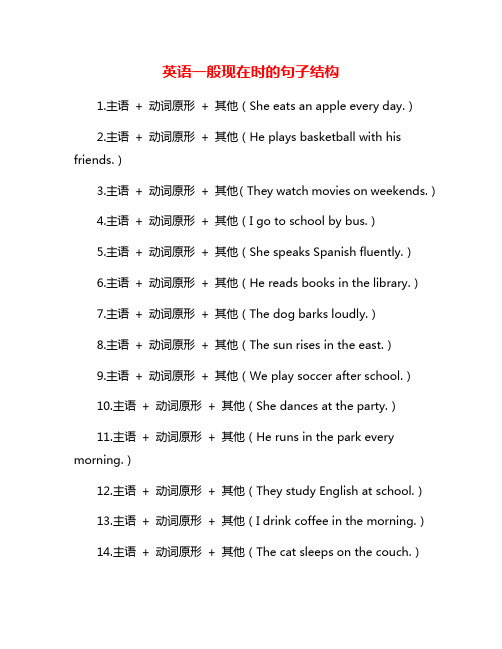
英语一般现在时的句子结构1.主语+ 动词原形+ 其他(She eats an apple every day.)2.主语+ 动词原形+ 其他(He plays basketball with his friends.)3.主语+ 动词原形+ 其他(They watch movies on weekends.)4.主语+ 动词原形+ 其他(I go to school by bus.)5.主语+ 动词原形+ 其他(She speaks Spanish fluently.)6.主语+ 动词原形+ 其他(He reads books in the library.)7.主语+ 动词原形+ 其他(The dog barks loudly.)8.主语+ 动词原形+ 其他(The sun rises in the east.)9.主语+ 动词原形+ 其他(We play soccer after school.)10.主语+ 动词原形+ 其他(She dances at the party.)11.主语+ 动词原形+ 其他(He runs in the park every morning.)12.主语+ 动词原形+ 其他(They study English at school.)13.主语+ 动词原形+ 其他(I drink coffee in the morning.)14.主语+ 动词原形+ 其他(The cat sleeps on the couch.)15.主语+ 动词原形+ 其他(The birds sing in the trees.)16.主语+ 动词原形+ 其他(He drives a car to work.)17.主语+ 动词原形+ 其他(She teaches math in the classroom.)18.主语+ 动词原形+ 其他(We swim in the pool on hot days.)19.主语+ 动词原形+ 其他(He checks his email every hour.)20.主语+ 动词原形+ 其他(They clean their room every Saturday.)21.She goes to school every day.22.They watch TV in the evening.23.He plays football on weekends.24.I love to eat pizza for dinner.25.We learn English at school.26.She brushes her teeth before bed.27.He reads books in his free time.28.They speak Spanish fluently.29.I listen to music while doing homework.30.She dances beautifully at the party.31.We drink coffee in the morning.32.He cooks dinner for the family.33.They walk their dog in the park.34.I study for exams every day.35.She watches movies on weekends.36.He helps his mom with chores.37.We play video games together.38.She goes shopping with her friends.39.They visit their grandparents every month.40.I swim in the pool during summer.41.She reads books every day.42.They go to school by bus.43.I play basketball on weekends.44.He watches TV in the evening.45.We eat breakfast together.46.You listen to music while studying.47.The dog barks when someone knocks on the door.48.She always arrives early for meetings.49.My parents work in the city.50.The sun rises in the east.51.Birds sing in the morning.52.The baby sleeps in the afternoon.53.He drinks coffee in the morning.54.I walk to the park after dinner.55.The train departs on time.56.She smiles when she sees her friends.57.They play soccer in the park.58.The cat chases the mouse.59.We study for exams together.60.He teaches English at the university.61.主语+ 动词原形(第三人称单数需加s/es)+ 其他62.主语+ 动词原形(第三人称单数需加s/es)+ 其他63.主语+ be动词(am/is/are)+ 其他64.主语+ be动词(am/is/are)+ 形容词/名词/副词等65.主语+ have/has + 过去分词66.主语+ have/has + been + 现在分词/形容词/名词等67.主语+ have/has + been + 动词-ing68.主语+ have/has + 动词过去分词69.主语+ 动词原形(第三人称单数需加s/es)+ 时间状语70.主语+ be动词(am/is/are)+ 动词-ing71.主语+ 动词原形(第三人称单数需加s/es)+ 双宾语72.There be结构(There is/are)+ 主语73.主语+ do/does + 动词原形74.主语+ do/does not + 动词原形75.主语+ do/does + 主语补语76.主语+ do/does not + 主语补语77.疑问句结构(Yes/No问句)78.特殊疑问句结构(问句词+ 助动词+ 主语+ 其他)79.倒装句结构(动词/助动词+ 主语+ 其他)80.主语+ will/shall + 动词原形81.She plays basketball every evening.82.I enjoy reading books in my free time.83.He goes to the gym twice a week.84.They watch movies on weekends.85.We listen to music while cooking.86.The cat sleeps all day long.87.My parents work in the hospital.88.She teaches English at a language school.89.I play the guitar in a band.90.He always eats breakfast before work.91.They travel to different countries every summer.92.We visit our grandparents on holidays.93.The dog barks at strangers.94.She studies hard for exams.95.He speaks three languages fluently.96.I take the bus to school every morning.97.They walk their dog in the park.98.The students read books in the library.99.She dances ballet on weekends. 100.We go shopping at the mall.101.I eat breakfast every morning.102.She works at a bank.103.They play soccer on the weekends. 104.He watches TV after dinner.105.We go to the gym three times a week. 106.The cat sleeps in the sun.107.You drink coffee in the afternoon. 108.She reads books in her free time. 109.He listens to music while studying. 110.They walk to school every day. 111.I like to watch movies on Fridays. 112.She dances in the living room.113.We visit our grandparents on holidays. 114.He plays the guitar in a band.115.They speak Spanish fluently. 116.She teaches English to children. 117.I work from home on Mondays. 118.He cooks dinner for his family. 119.They go for a run in the park. 120.She practices yoga in the morning.。
一般现在时的构成及用法
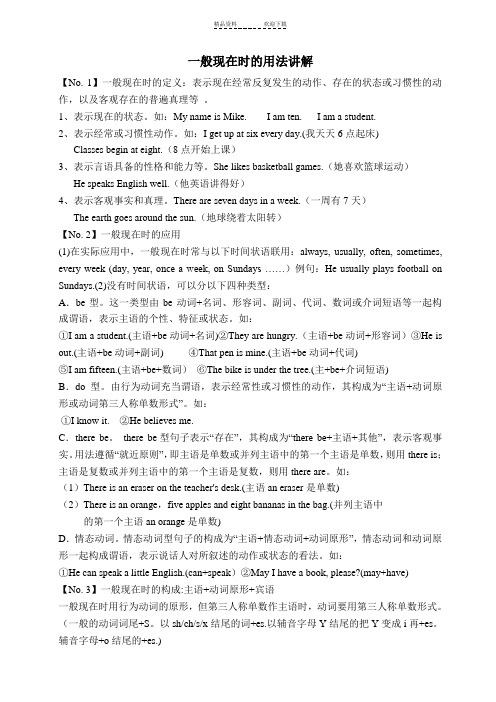
一般现在时的用法讲解【No. 1】一般现在时的定义:表示现在经常反复发生的动作、存在的状态或习惯性的动作,以及客观存在的普遍真理等。
1、表示现在的状态。
如:My name is Mike. I am ten. I am a student.2、表示经常或习惯性动作。
如:I get up at six every day.(我天天6点起床)Classes begin at eight.(8点开始上课)3、表示言语具备的性格和能力等。
She likes basketball games.(她喜欢篮球运动)He speaks English well.(他英语讲得好)4、表示客观事实和真理。
There are seven days in a week.(一周有7天)The earth goes around the sun.(地球绕着太阳转)【No. 2】一般现在时的应用(1)在实际应用中,一般现在时常与以下时间状语联用:always, usually, often, sometimes, every week (day, year, o nce a week, on Sundays ……)例句:He usually plays football on Sundays.(2)没有时间状语,可以分以下四种类型:A.be型。
这一类型由be动词+名词、形容词、副词、代词、数词或介词短语等一起构成谓语,表示主语的个性、特征或状态。
如:①I am a student.(主语+be动词+名词)②They are hungry.(主语+be动词+形容词)③He is out.(主语+be动词+副词) ④That pen is mine.(主语+be动词+代词)⑤I am fifteen.(主语+be+数词)⑥The bike is under the tree.(主+be+介词短语)B.do型。
由行为动词充当谓语,表示经常性或习惯性的动作,其构成为“主语+动词原形或动词第三人称单数形式”。
小学英语知识点归纳

小学英语知识点归纳一、名词复数规则1.一般情况下,直接加-s,如:book-books, bag-bags, cat-cats, bed-beds2.以s,x,sh,ch结尾,加-es,如:bus-buses, box-boxes, brush-brushes, watch-watches 3.以“辅音字母y”结尾,变y为i, 再加-es,如:family-families, strawberry-strawberries4.以“f或fe”结尾,变f或fe为v, 再加-es,如:knife-knives Leaf-leaves 5.不规则名词复数:man-men, woman-women, policeman-policemen, policewoman-policewomen,child-children foot-feet, tooth-teeth fish-fish, people-people, Chinese-Chinese, Japanese-Japanese二、一般现在时一般现在时基本用法介绍【No. 1】一般现在时的功能1.表示事物或人物的特征、状态。
如:The sky is blue.天空是蓝色的。
2.表示经常性或习惯性的动作。
如:I get up at six every day.我天天六点起床。
3.表示客观现实。
如:The earth goes around the sun.地球绕着太阳转。
一般现在时的构成1. be动词:主语be(am,is,are) 其它。
如: I am a boy.我是一个男孩。
2.行为动词:主语行为动词( 其它)。
如: We study English.我们学习英语。
当主语为第三人称单数(he, she,it)时,要在动词后加"-s"或"-es"。
如:Mary likes Chinese.玛丽喜欢汉语。
【No. 2】一般现在时的变化1. be动词的变化。
小学英语(3-6年级)语法知识大全(陕旅版)
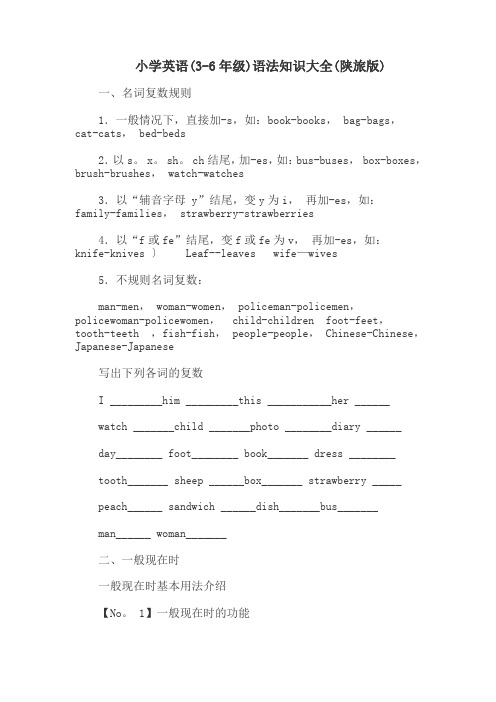
小学英语(3-6年级)语法知识大全(陕旅版)一、名词复数规则1.一般情况下,直接加-s,如:book-books, bag-bags,cat-cats, bed-beds2.以s。
x。
sh。
ch结尾,加-es,如:bus-buses, box-boxes,brush-brushes, watch-watches3.以“辅音字母 y”结尾,变y为i,再加-es,如:family-families, strawberry-strawberries4.以“f或fe”结尾,变f或fe为v,再加-es,如:knife-knives 〕Leaf--leaves wife—wives5.不规则名词复数:man-men, woman-women, policeman-policemen,policewoman-policewomen,child-children foot-feet,tooth-teeth ,fish-fish, people-people, Chinese-Chinese,Japanese-Japanese写出下列各词的复数I _________him _________this ___________her ______watch _______child _______photo ________diary ______day________ foot________ book_______ dress ________tooth_______ sheep ______box_______ strawberry _____peach______ sandwich ______dish_______bus_______man______ woman_______二、一般现在时一般现在时基本用法介绍【No。
1】一般现在时的功能1。
表示事物或人物的特征、状态。
如:The sky is blue。
一般现在时用法讲解

A. will have B. will be
C. have
4. We__ to the park if it is fine tomorrow.
A. will go B. go
C. to go
If 引导的条件状语从句
用法:
1. 如果主句是一般将来时,从句则用一般现在时. If it rains从句, I will stay at home. I’ll go with you if you don’t want to go alone从句.
动词单三人称形式的构成:
1. 一般的动词词尾+S.2. 以sh/ch/s/x 结尾的词+es. 3. 以辅音字母Y结尾的把Y 变成 i,+es.4. 辅音字母+o 结尾的+es.
2. 否定句 1主语 +am / is / are + not +表语
如:She is not a nurse. 她不是护士. We are not in the same class, but we are in
3. 一般疑问句 1Am / Is / Are +主语 +表语 如:Is your mother a teacher 你妈妈是老师吗
Are you from China. 你来自中国吗 2a. Do + 主语 +动词原形 +其它 b. Does +单三 人称主语+动词原形+其它 如: Do you speak English 你说英语吗
一般现在时用法讲解
一、 一般现在时用法歌诀
学习一般现在时, 基本用法要熟悉; 特征性格和能力, 客观事实与真理; 发生动作经常性, 存在状态和习惯; 以上歌诀念几遍, 把握还需多多练.
英语一般现在时用法及构成

一般现在时基本结构:通常与副词every day(每天),always(总是),usually(通常),often(经常)sometimes(有时),等时间状语连用。
1.表示事物或人物的特征、状态。
例句:The sky is blue.天空是蓝色的。
2.表示经常性或习惯性的动作。
例句:I get up at six every day.我每天六点起床。
3.表示客观现实。
例句:The table has four legs.桌子有四条腿。
4.表示客观真理,科学原理,自然现象,等客观事实或格言谚语等。
例句:The earth goes around the sun.地球绕着太阳转。
一般现在时的用法:1.表示经常性或习惯性的动作或存在的状态;表示客观事实或普遍真理;在时间、条件等状语从句中,用现在时表示将来;在某些以here,there开头的句子中,用一般现在时表示正在发生的动。
例句:He is twelve.他十二岁了。
I go to school at seven every day.我每天七点去上学。
2.一般现在时常和表示时间的频度副词连用。
如:often, usually, sometimes, always, never等。
例句:I often read books in the evening.我经常在晚上读书。
Do they usually go to school by bike?他们通常骑自行车去上学吗?He doesn’t like milk. He never drinks it.他不喜欢牛奶。
他从来不喝它。
Sometimes my mother gets back at five.有时候妈妈五点钟回来。
3.一般现在时也常和以下时间表达法连用。
例句:Do they have math in the morning?他们早上有数学课吗?She sleeps nine hours every night.她每晚睡九个小时。
一般过去时现在进行时一般现在时时态讲解、练习

3.末尾只有一个元音字母和一个辅 音字母的重读闭音节,应双写末尾的辅 音字母,再加-ed,如:stop-stopped 4.以“辅音字母 +y”结尾的,变y 为i, 再加-ed,如:study-studied
am,is-was, are-were, do-did, seesaw, say-said, give-gave, get-got, gowent, come-came, have-had, eat-ate, take-took, run-ran, sing-sang, putput, make-made, read-read, writewrote, draw-drew, drink-drank, swimswam, sit-sat ,sweep-swept
I didn’t go to school yesterday.
_______________________________________________
Did she play volleyball just now.
3、特殊疑问句由疑问词+did+主语+动词原形组成。
如:They visited the farm last Sunday.(对划线部分提问)
did danced does_________ dance________ worried asked worry________ ask _____ ate tasted taste_________ eat__________ put put ______ passed do kicked kick_________ pass_______ did ________
Where did they visit the farm? ____________________________________________
一般现在时的构成及用法
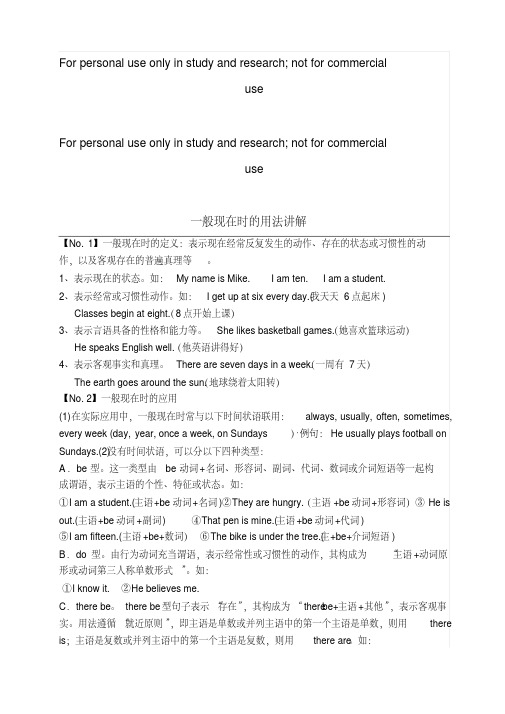
For personal use only in study and research; not for commercialuseFor personal use only in study and research; not for commercialuse一般现在时的用法讲解【No. 1】一般现在时的定义:表示现在经常反复发生的动作、存在的状态或习惯性的动作,以及客观存在的普遍真理等。
1、表示现在的状态。
如:My name is Mike. I am ten. I am a student.2、表示经常或习惯性动作。
如:I get up at six every day.(我天天6点起床)Classes begin at eight.(8点开始上课)3、表示言语具备的性格和能力等。
She likes basketball games.(她喜欢篮球运动)He speaks English well.(他英语讲得好)4、表示客观事实和真理。
There are seven days in a week.(一周有7天)The earth goes around the sun.(地球绕着太阳转)【No. 2】一般现在时的应用(1)在实际应用中,一般现在时常与以下时间状语联用:always, usually, often, sometimes,)例句:He usually plays football on every week (day, year, once a week, on Sundays ……Sundays.(2)没有时间状语,可以分以下四种类型:A.be型。
这一类型由be动词+名词、形容词、副词、代词、数词或介词短语等一起构成谓语,表示主语的个性、特征或状态。
如:①I am a student.(主语+be动词+名词)②They are hungry.(主语+be动词+形容词)③He is out.(主语+be动词+副词) ④That pen is mine.(主语+be动词+代词)⑤I am fifteen.(主语+be+数词)⑥The bike is under the tree.(主+be+介词短语)B.do型。
一般现在时结构

一般现在时结构一般现在时是英语中最基础也是最常用的时态之一。
它表示的是经常性、习惯性或普遍性的动作、状态或事实。
本文将介绍一般现在时的结构及其用法。
一般现在时的结构非常简单,无论是肯定句、否定句还是疑问句,其基本结构都是主语+动词原形。
1. 肯定句结构:主语 + 动词原形(一般动词加“-s”或“-es”)例如:- I study English every day.(我每天学习英语。
)- Coffee tastes good.(咖啡很好喝。
)需要注意的是,第三人称单数的主语需要在动词后面加上“-s”或“-es”。
例如,he/she/it后的动词发生变化:- She plays the piano very well.(她弹钢琴弹得很好。
)- It rains a lot in this area.(这个区域经常下雨。
)2. 否定句结构:主语 + do/does + not + 动词原形例如:- I do not watch TV in the morning.(早上我不看电视。
)- He does not like vegetables.(他不喜欢蔬菜。
)在否定句中,我们需要在助动词“do/does”后加上“not”,表示否定。
需要注意的是,第三人称单数的主语后的助动词变为“does”。
3. 疑问句结构:Do/Does + 主语 + 动词原形?例如:- Do you like sports?(你喜欢运动吗?)- Does she live in that house?(她住在那栋房子里吗?)在疑问句中,我们需要将助动词“do/does”提前到主语之前,来构成疑问句。
需要注意的是,第三人称单数的主语后的助动词为“does”。
一般现在时有以下几种常见的用法:1. 表示经常性动作或习惯:- I go to the gym every Monday.(我每个星期一去健身房。
)- She brushes her teeth twice a day.(她每天刷两次牙。
一般现在时的结构形式
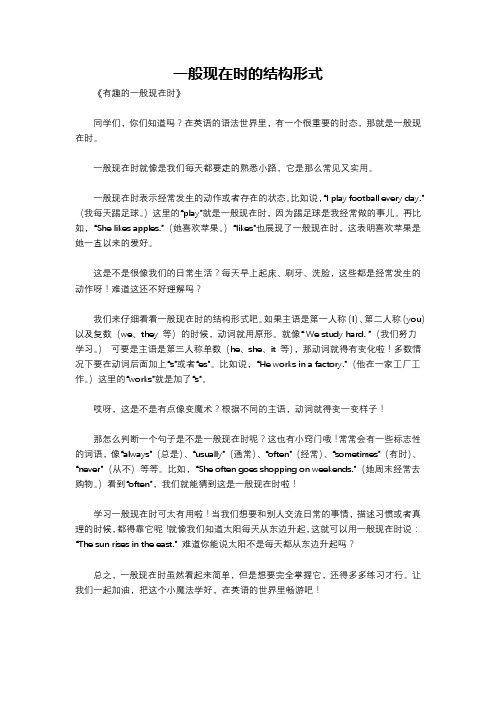
一般现在时的结构形式《有趣的一般现在时》同学们,你们知道吗?在英语的语法世界里,有一个很重要的时态,那就是一般现在时。
一般现在时就像是我们每天都要走的熟悉小路,它是那么常见又实用。
一般现在时表示经常发生的动作或者存在的状态。
比如说,“I play football every day.”(我每天踢足球。
)这里的“play”就是一般现在时,因为踢足球是我经常做的事儿。
再比如,“She likes apples.”(她喜欢苹果。
)“likes”也展现了一般现在时,这表明喜欢苹果是她一直以来的爱好。
这是不是很像我们的日常生活?每天早上起床、刷牙、洗脸,这些都是经常发生的动作呀!难道这还不好理解吗?我们来仔细看看一般现在时的结构形式吧。
如果主语是第一人称(I)、第二人称(you)以及复数(we、they 等)的时候,动词就用原形。
就像“ We study hard. ”(我们努力学习。
)可要是主语是第三人称单数(he、she、it 等),那动词就得有变化啦!多数情况下要在动词后面加上“s”或者“es”。
比如说,“He works in a factory.”(他在一家工厂工作。
)这里的“works”就是加了“s”。
哎呀,这是不是有点像变魔术?根据不同的主语,动词就得变一变样子!那怎么判断一个句子是不是一般现在时呢?这也有小窍门哦!常常会有一些标志性的词语,像“always”(总是)、“usually”(通常)、“often”(经常)、“sometimes”(有时)、“never”(从不)等等。
比如,“She often goes shopping on weekends.”(她周末经常去购物。
)看到“often”,我们就能猜到这是一般现在时啦!学习一般现在时可太有用啦!当我们想要和别人交流日常的事情,描述习惯或者真理的时候,都得靠它呢!就像我们知道太阳每天从东边升起,这就可以用一般现在时说:“The sun rises in the east.” 难道你能说太阳不是每天都从东边升起吗?总之,一般现在时虽然看起来简单,但是想要完全掌握它,还得多多练习才行。
英语一般现在时的基本结构
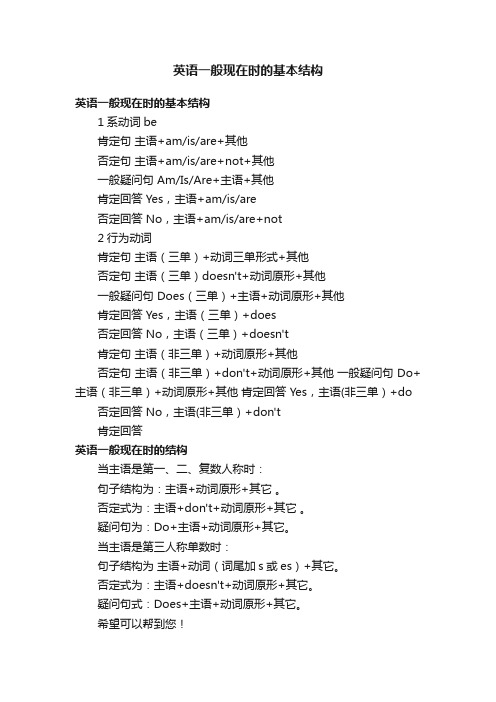
英语一般现在时的基本结构英语一般现在时的基本结构1系动词be肯定句主语+am/is/are+其他否定句主语+am/is/are+not+其他一般疑问句 Am/Is/Are+主语+其他肯定回答 Yes,主语+am/is/are否定回答 No,主语+am/is/are+not2行为动词肯定句主语(三单)+动词三单形式+其他否定句主语(三单)doesn't+动词原形+其他一般疑问句 Does(三单)+主语+动词原形+其他肯定回答 Yes,主语(三单)+does否定回答 No,主语(三单)+doesn't肯定句主语(非三单)+动词原形+其他否定句主语(非三单)+don't+动词原形+其他一般疑问句 Do+主语(非三单)+动词原形+其他肯定回答 Yes,主语(非三单)+do 否定回答 No,主语(非三单)+don't肯定回答英语一般现在时的结构当主语是第一、二、复数人称时:句子结构为:主语+动词原形+其它。
否定式为:主语+don't+动词原形+其它。
疑问句为:Do+主语+动词原形+其它。
当主语是第三人称单数时:句子结构为主语+动词(词尾加s或es)+其它。
否定式为:主语+doesn't+动词原形+其它。
疑问句式:Does+主语+动词原形+其它。
希望可以帮到您!1be 动词肯定句:主语加am/is/are加其他否定句:主语加 am/is/are 加not 加其他疑问句:am/is/are加主语加其他2行为动词肯定句:主语加动词原形/动词第三人称单数形式否定句:主语加don't/doesn't 加动词原形疑问句:do/does 加主语加动词原形英语一般现在时的结构和用法以clean为例 (三单+s\es)I clean we cleanyou clean you clean + the classroom.he\she\it cleans they clean疑问句Do you(we,they,I) clean the classroom?Does he(she,) clean the classroom?英语一般现在时的结构和特点一般现在时的句子结构1、当句子表状态说明主语是什么或怎么样时,其句型:主+BE动词(am, is, are)+表语,否定式是在BE动词后加not,疑问句是将BE动词提前到句首(即在主语之前)e.g. The in sisters are from America. 这对孪生姐妹是美国人。
所有16种时态
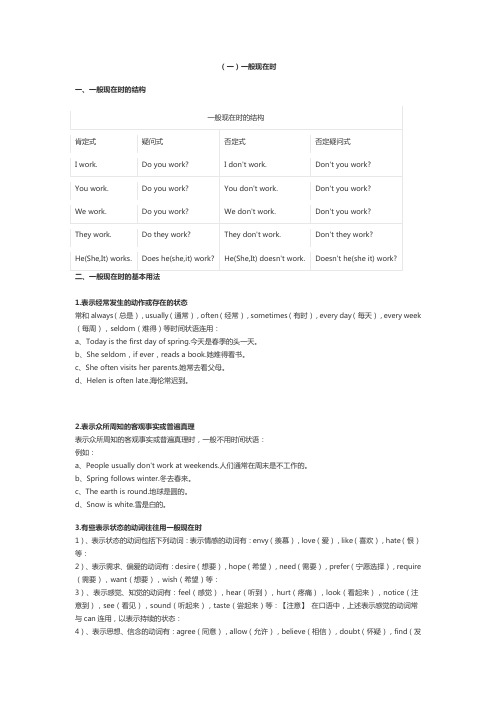
(一)一般现在时一、一般现在时的结构一般现在时的结构肯定式疑问式否定式否定疑问式I work. Do you work? I don't work. Don't you work?You work. Do you work? You don't work. Don't you work?We work. Do you work? We don't work. Don't you work?They work. Do they work? They don't work. Don't they work?He(She,It) works. Does he(she,it) work? He(She,It) doesn't work. Doesn't he(she it) work?二、一般现在时的基本用法1.表示经常发生的动作或存在的状态常和always(总是),usually(通常),often(经常),sometimes(有时),every day(每天),every week (每周),seldom(难得)等时间状语连用:a、Today is the first day of spring.今天是春季的头一天。
b、She seldom,if ever,reads a book.她难得看书。
c、She often visits her parents.她常去看父母。
d、Helen is often late.海伦常迟到。
2.表示众所周知的客观事实或普遍真理表示众所周知的客观事实或普遍真理时,一般不用时间状语:例如:a、People usually don't work at weekends.人们通常在周末是不工作的。
b、Spring follows winter.冬去春来。
c、The earth is round.地球是圆的。
英语时态做题技巧
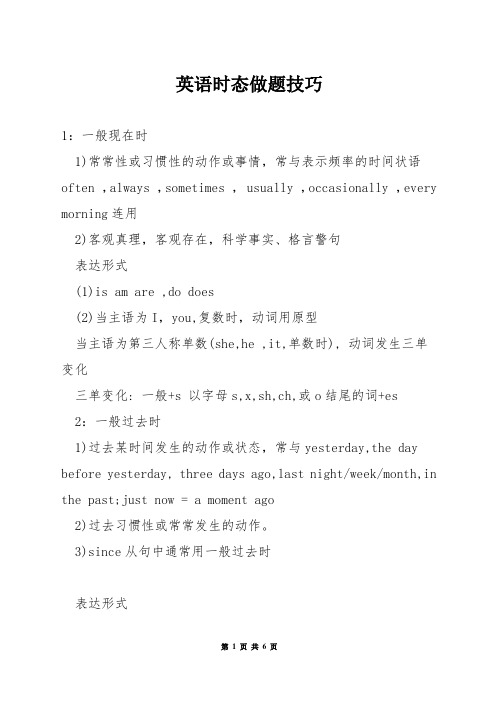
英语时态做题技巧1:一般现在时1)常常性或习惯性的动作或事情,常与表示频率的时间状语often ,always ,sometimes , usually ,occasionally ,every morning连用2)客观真理,客观存在,科学事实、格言警句表达形式(1)is am are ,do does(2)当主语为I,you,复数时,动词用原型当主语为第三人称单数(she,he ,it,单数时), 动词发生三单变化三单变化: 一般+s 以字母s,x,sh,ch,或o结尾的词+es2:一般过去时1)过去某时间发生的动作或状态,常与yesterday,the day before yesterday, three days ago,last night/week/month,in the past;just now = a moment ago2)过去习惯性或常常发生的动作。
3)since从句中通常用一般过去时表达形式(1) was were ,did(2) 动词过去时的规则变化:一般在动词后+ed辅音字母+y 改y为i+ed以e 结尾的+ed3:一般将来时1)表示将来会发生的动作或状态,常与时间状语连用.标志词:tomorrow,the day after tomorrow,in three days,in (the) future,next week/month/term, from now on。
表达形式will shall(第一人称)+动原第一人称用shall,常被will替换。
2) shall/will/be going to之间的区别:shall往往用于第一人称疑问句, will可用于任何人称。
will常用于表邀请或命令时以及带有意愿色彩。
计划决定要做某事,一般用be going to do 结构。
2英语学习小窍门1、没有必要做太多的计划,但计划一旦做出,就无论如何要做到。
2、天天记住的最正确单词量应该是在200-300之间。
- 1、下载文档前请自行甄别文档内容的完整性,平台不提供额外的编辑、内容补充、找答案等附加服务。
- 2、"仅部分预览"的文档,不可在线预览部分如存在完整性等问题,可反馈申请退款(可完整预览的文档不适用该条件!)。
- 3、如文档侵犯您的权益,请联系客服反馈,我们会尽快为您处理(人工客服工作时间:9:00-18:30)。
一般现在时的疑问句
一、一般现在时变否定句的规则.
一)、主语+be动词
1、疑问句结构: be + 主语+ 其它部分?
2、变换方法:一提二变三问号
一提:即把句中的be动词调到句首;
二变:改换主语称谓,即将句中的主语I\my \mines\we\our\ours等第一人称分别改为相应的第二人称you\your\ yours等;
三问号:句末的句号改为问号.
3、回答
肯定回答用“Yes,主语+be.”,
否定回答用“No,主语+be +not.
但要注意人称的变化、在回答时必须将this\that与these\those分别变为it 和they。
【例】1、陈述句The girl is his sister.
主语be动词
疑问句Is the girl his sister ?
be动词主语问号
回答:肯定回答Yes, she is.
否定回答No, she isn’t.
2、陈述句He is a teacher.
主语be动词
疑问句Is he a teacher ?
be动词主语问号
回答:肯定回答Yes, he is.
否定回答No, he isn’t.
3、陈述句I am a teacher .
主语be动词
疑问句Are you a teacher ?
be动词主语问号
回答:肯定回答Yes, I am.
否定回答No, I am not.
4、陈述句 These are your English books.
主语be动词
疑问句Are these your English books?
be动词主语问号
回答:肯定回答Yes, they are.
否定回答No, they aren’t.
5、陈述句This is your English books .
主语be动词
疑问句Is this your English books?
be动词主语问号
回答:肯定回答Yes, It is.
否定回答No, It isn’t
二)、主语+情态动词
1、疑问句结构:情态动词+ 主语+ 动词原形+ 其它部分?
2、变换方法:一提二变三问号
一提:即把句中的情态动词调到句首;
二变:改换主语称谓,即将句中的主语I\my \mines\we\our\ours等第一人称分别改为相应的第二人称you\your\ yours等;
三问号:句末的句号改为问号.
3、回答
肯定回答用“Yes,主语+情态动词.”,
否定回答用“No,主语+情态动词+not
但要注意人称的变化
【例】1、陈述句I can speak English.
主语be动词
疑问句Can you speak English ?
be动词主语问号
回答:肯定回答Yes, I can.
否定回答No, I can’t.
三)、主语+实义动词
1、疑问句结构
当主语是第一人称;第二人称及第三人称复数及复数名词时:
结构:Do+主语+实义动词+其他
当主语是第三人称单数及单数名词时
结构:Does+主语+实义动词原形+其他
【例】1、陈述句He plays Ping-pang every day.
主语义动词的第三人称单数形式
疑问句Does he play Ping-pang every day.
Does 主语动词原型
回答:肯定回答Yes, he does.
否定回答No, he doesn’t.
四)、注意
1、含有have和has的句子变成疑问句,把have和has看着实义动词,用do和does提问,但has要变成have
【例】1、陈述句I have big eyes..
疑问句Do you have big eyes?
回答:肯定回答Yes,I do.
否定回答NO,I don't.
2、陈述句She has a small mouth.
疑问句Does she have a small mouth?
回答:肯定回答Yes,she does.
否定回答No, she doesn't.
2、见到some 变否定句时,要换成any.
3、见到and 变否定句时,要换成or.
4、见到too和also变否定句时,要换成either.
5、见到already变否定句时,要换成yet。
6、a lot of (=lots of)变为many(可数名词)或much(不可数名词)。
